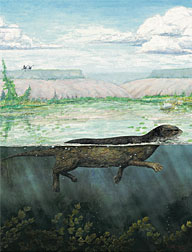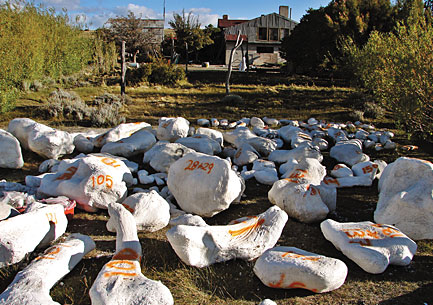|
 |
The webbed link
For decades, vertebrate paleontologists had more than just a hunch that pinnipeds—the group of animals that today includes seals, sea lions, and walruses—once had legs. But the evidence of when these modern-day sea dwellers actually walked, not waddled, on dry land was always missing. Until now.
Illustration: Mark A. Klingler/Carnegie
Museum of Natural History
 One of Carnegie Museum of Natural History’s most acclaimed researchers, Curator Emeritus of Vertebrate Paleontology Mary Dawson, is a member of the international team that recently published its discovery of what could be the missing link in the evolution of these carnivorous animals. While on a dig in the Canadian Arctic, Dawson helped uncover a nearly complete fossil of a primitive “walking seal,” with four legs and webbed feet, dating back some 23 million years. The researchers dubbed the newfound species Puijila darwini. Puijila is Inuit for “young sea mammal” and darwini is for naturalist Charles Darwin, who predicted 150 years ago that animals that occasionally hunted for food in shallow water would eventually adapt to sea life. The findings were published in April in the journal Nature. One of Carnegie Museum of Natural History’s most acclaimed researchers, Curator Emeritus of Vertebrate Paleontology Mary Dawson, is a member of the international team that recently published its discovery of what could be the missing link in the evolution of these carnivorous animals. While on a dig in the Canadian Arctic, Dawson helped uncover a nearly complete fossil of a primitive “walking seal,” with four legs and webbed feet, dating back some 23 million years. The researchers dubbed the newfound species Puijila darwini. Puijila is Inuit for “young sea mammal” and darwini is for naturalist Charles Darwin, who predicted 150 years ago that animals that occasionally hunted for food in shallow water would eventually adapt to sea life. The findings were published in April in the journal Nature.
An art-felt entrance
photo: courtesy of LACMA
 Lynn Zelevansky, one of the country’s most lauded curators of contemporary art, has been named the Henry J. Heinz II Director of Carnegie Museum of Art. Lynn Zelevansky, one of the country’s most lauded curators of contemporary art, has been named the Henry J. Heinz II Director of Carnegie Museum of Art.
Zelevansky spent the last 14 years at the Los Angeles County Museum of Art, currently as the Terri and Michael Smooke Curator and Department Head of Contemporary Art. Prior to working in Los Angeles, Zelevansky spent seven years in the department of painting and sculpture at New York’s Museum of Modern Art.
“Lynn’s work as a writer, educator, and incredibly thoughtful art curator has been leading her to such a position for quite some time,” says David Hillenbrand, president of Carnegie Museums. “We’re thrilled that our search coincided with her readiness to take on the director’s role at a respected institution such as Carnegie Museums.” Zelevansky takes the reins July 15.
The native New Yorker is not new to Pittsburgh, having attended Carnegie Mellon University for two years as an undergraduate before returning to New York to earn a BFA at Pratt Institute and an MA in photography at New York University’s Institute of Fine Arts. She started her career as a university arts professor and photographer.
“This is a museum with an incredible reputation, and it has enormous potential for making even greater contributions regionally, nationally, and internationally,” says Zelevansky. “Pittsburgh is a city with an indomitable spirit; I’m so impressed with its ongoing cultural and economic vitality.”
Carnegie Museums began its search for a new director last summer, after Richard Armstrong, now the director of the Solomon R. Guggenheim Foundation, announced he would be leaving the museum. In honor of Armstrong’s 16-year tenure at the Museum of Art, the museum has established an endowed contemporary art curator’s position bearing his name. To date, more than $600,000 of a $2 million goal has been raised. To contribute, call 412.622.1996.
High marks for SportsWorks®
 Carnegie Science Center’s popular SportsWorks®, the only science-of-sport exhibit of its kind in western Pennsylvania, will not only have a new home when it reopens this fall but a new name. Carnegie Science Center’s popular SportsWorks®, the only science-of-sport exhibit of its kind in western Pennsylvania, will not only have a new home when it reopens this fall but a new name.
Highmark SportsWorks®, the product of a three-year partnership between the North Shore museum and the health care provider, will debut in a brand-new facility adjacent to the main Science Center building designed especially for the science-of-health and -sport exhibit later this year. The revamped exhibit will feature past favorites, such as the trampoline, Orbitron, and virtual volleyball, combined with new interactive experiences, many related to healthy living.
Girls + science = an innovative future
 Calling all teen girls … science is a cool and fun way to make a difference. That’s what the Girls, Math & Science Partnership (GMSP), a program of Carnegie Science Center, hopes to achieve with its new toolkit, Can*TEEN. Today, women still lag behind their male counterparts in careers in science, technology, engineering, and math. And more than 2,000 science jobs are left unfilled each year in the Pittsburgh region due to an under-qualified workforce, so ensuring that the future is full of a diverse group of innovators—including women—is essential to Pittsburgh’s economic wellbeing. Calling all teen girls … science is a cool and fun way to make a difference. That’s what the Girls, Math & Science Partnership (GMSP), a program of Carnegie Science Center, hopes to achieve with its new toolkit, Can*TEEN. Today, women still lag behind their male counterparts in careers in science, technology, engineering, and math. And more than 2,000 science jobs are left unfilled each year in the Pittsburgh region due to an under-qualified workforce, so ensuring that the future is full of a diverse group of innovators—including women—is essential to Pittsburgh’s economic wellbeing.
GMSP is aimed at closing this gap by helping young girls realize that they, too, can change the world by using science. Can*TEEN, unveiled this past April, is an innovative toolkit that uses eight illustrated female characters to lead girls ages 10 and older through an exploration of careers, from chemist to archeologist to techie. Multimedia resources feature female role models in all the sciences, hands-on and online activities, information on middle and high school class selection and scholarships, plus actual tools to put their new skills to work: a periodic table, calculator, ruler, and journal. Check it out at www.BrainCake.org/canteen.

Check out the size of those bones!
Visitors to Carnegie Museum of Natural History this summer can literally watch history unfold as bones from one of the largest dinosaurs ever discovered are unpacked and cleaned in the museum’s first-floor exhibit, PaleoLab.

Paleontologist Matt Lamanna, the museum’s chief dinosaur hunter, was part of a 2005 research team that unearthed an approximately 70-million-year-old fossil
skeleton in Patagonia, Argentina, belonging to a long-necked, plant-eating sauropod that once tipped the scale at up to 60 tons—the weight of a dozen elephants. The team hit the dinosaur jackpot, as it’s arguably the most complete skeleton ever found of a super-massive dinosaur.
Sixteen tons of the beast’s bones, still encased in their protective plaster “jackets,” were shipped to Drexel University in May, and many of the unopened “jackets” (dozens shown above while still stored at a ranch in Patagonia) will make their way to Pittsburgh to be prepared and conserved—in view of the public—by museum fossil preparators Norm Wuerthele, Allen Shaw, and Dan Pickering. Lamanna will then collaborate with Drexel University paleontologist Ken Lacovara to study the ginormous creature. The fossils will eventually return home to Argentina for display.
Champions of science
The City of Champions recently recognized a few more of its own when Carnegie Science Center honored the winners of this year’s Carnegie Science Awards, sponsored by Eaton Corporation. The formal celebration, held at Carnegie Music Hall on May 8, adopted a timely “Shades of Green” theme in honor of its guest speaker, award-winning actor and environmentalist Ed Begley, Jr.
This year’s Chairman’s Award winner was a familiar name to Pittsburghers everywhere—Westinghouse Electric Company, a legendary western Pennsylvania institution still making big waves as a leader and innovator in nuclear power technologies. Following are the other winners. Advanced Manufacturing: Karen Craig, Dirk Kammermier, Ph.D., Kennametal. Advanced Materials: Robert Hunt, Brian Long, Rick Starcher, Bayer MaterialScience LLC. Catalyst: Lenore Blum, Ph.D., Computer Science Department, Carnegie Mellon University. Corporate Innovation: Idea Foundry. Start-up Entrepreneur: David Palmer, ClearCount Medical Solutions. Entrepreneur: D. Raja, Computer Enterprises, Inc. Environmental: Rebecca Flora, AICP, LEED AP, U.S. Green Building Council. Information Technology: Peter Feiler, Ph.D., Software Engineering Institute, Carnegie Mellon University. Journalism: Joe Miksch, Pitt Med magazine. Life Sciences: Yuan Chang, M.D., Patrick Moore, M.D., MPH, University of Pittsburgh Cancer Institute. Emerging Female Scientist: Priya Narasimhan, Ph.D., Carnegie Mellon University. Elementary Educator: Cyndy Carroll, Canon-McMillan School District. Middle Level Educator: Maribeth Varganin, Quaker Valley School District. High School Educator: William Diehl, Anita Schuchardt, Ph.D., Shady Side Academy. School District: Derry Area School District. University/Post-Secondary Educator: John F. Mahoney, M.D., University of Pittsburgh School of Medicine. University/Post-Secondary Student: Donna J. Haworth, University of Pittsburgh.
|
 Summer 2009
Summer 2009

 One of Carnegie Museum of Natural History’s most acclaimed researchers, Curator Emeritus of Vertebrate Paleontology Mary Dawson, is a member of the international team that recently published its discovery of what could be the missing link in the evolution of these carnivorous animals. While on a dig in the Canadian Arctic, Dawson helped uncover a nearly complete fossil of a primitive “walking seal,” with four legs and webbed feet, dating back some 23 million years. The researchers dubbed the newfound species Puijila darwini. Puijila is Inuit for “young sea mammal” and darwini is for naturalist Charles Darwin, who predicted 150 years ago that animals that occasionally hunted for food in shallow water would eventually adapt to sea life. The findings were published in April in the journal Nature.
One of Carnegie Museum of Natural History’s most acclaimed researchers, Curator Emeritus of Vertebrate Paleontology Mary Dawson, is a member of the international team that recently published its discovery of what could be the missing link in the evolution of these carnivorous animals. While on a dig in the Canadian Arctic, Dawson helped uncover a nearly complete fossil of a primitive “walking seal,” with four legs and webbed feet, dating back some 23 million years. The researchers dubbed the newfound species Puijila darwini. Puijila is Inuit for “young sea mammal” and darwini is for naturalist Charles Darwin, who predicted 150 years ago that animals that occasionally hunted for food in shallow water would eventually adapt to sea life. The findings were published in April in the journal Nature.  Lynn Zelevansky, one of the country’s most lauded curators of contemporary art, has been named the Henry J. Heinz II Director of Carnegie Museum of Art.
Lynn Zelevansky, one of the country’s most lauded curators of contemporary art, has been named the Henry J. Heinz II Director of Carnegie Museum of Art.  Carnegie Science Center’s popular SportsWorks®, the only science-of-sport exhibit of its kind in western Pennsylvania, will not only have a new home when it reopens this fall but a new name.
Carnegie Science Center’s popular SportsWorks®, the only science-of-sport exhibit of its kind in western Pennsylvania, will not only have a new home when it reopens this fall but a new name.  Calling all teen girls … science is a cool and fun way to make a difference. That’s what the Girls, Math & Science Partnership (GMSP), a program of Carnegie Science Center, hopes to achieve with its new toolkit, Can*TEEN. Today, women still lag behind their male counterparts in careers in science, technology, engineering, and math. And more than 2,000 science jobs are left unfilled each year in the Pittsburgh region due to an under-qualified workforce, so ensuring that the future is full of a diverse group of innovators—including women—is essential to Pittsburgh’s economic wellbeing.
Calling all teen girls … science is a cool and fun way to make a difference. That’s what the Girls, Math & Science Partnership (GMSP), a program of Carnegie Science Center, hopes to achieve with its new toolkit, Can*TEEN. Today, women still lag behind their male counterparts in careers in science, technology, engineering, and math. And more than 2,000 science jobs are left unfilled each year in the Pittsburgh region due to an under-qualified workforce, so ensuring that the future is full of a diverse group of innovators—including women—is essential to Pittsburgh’s economic wellbeing. 
